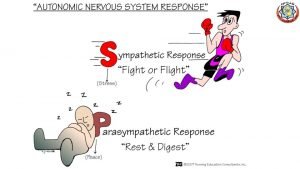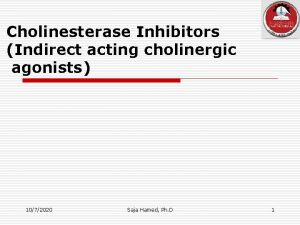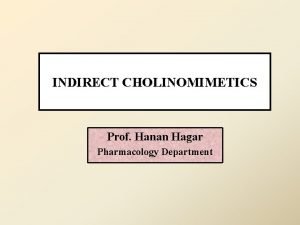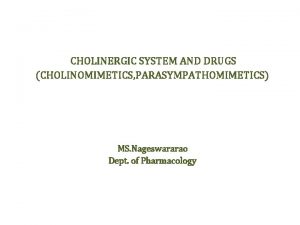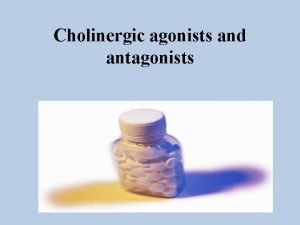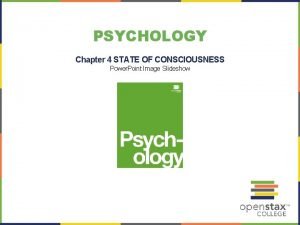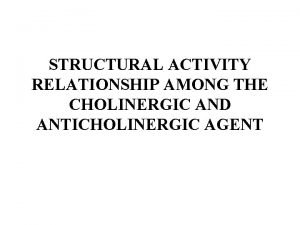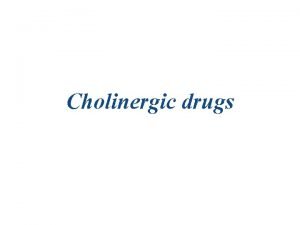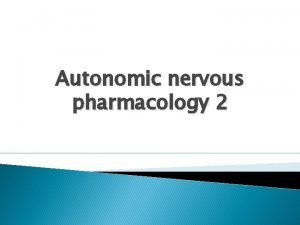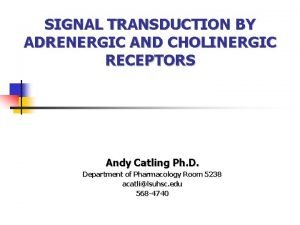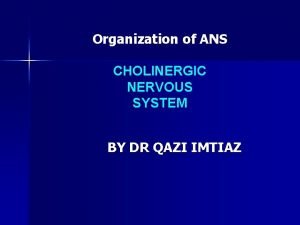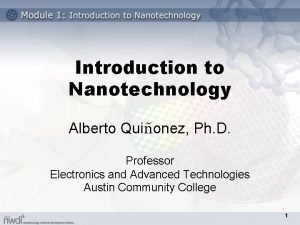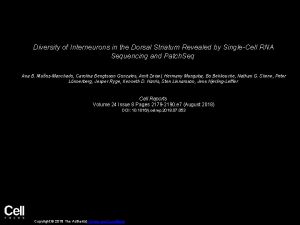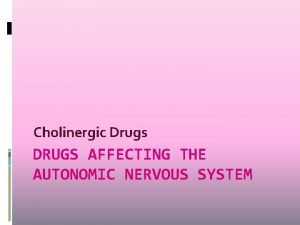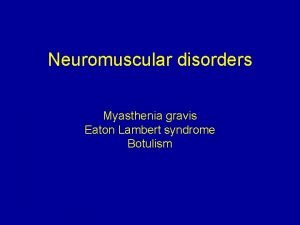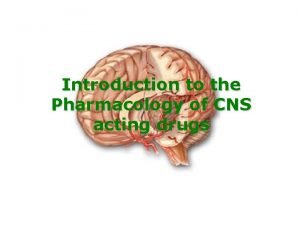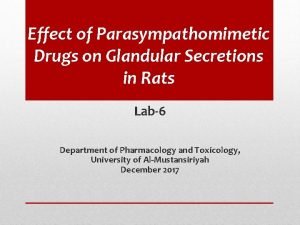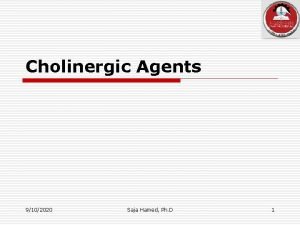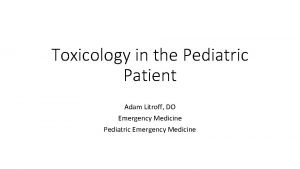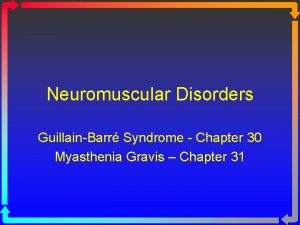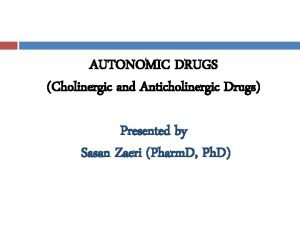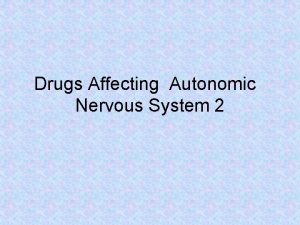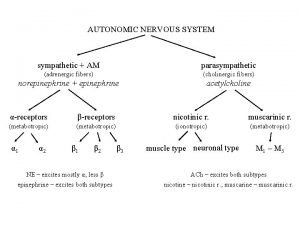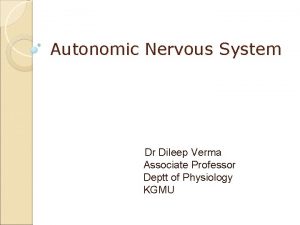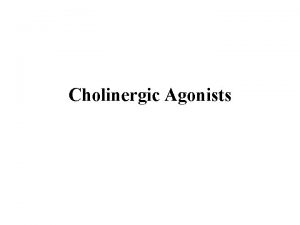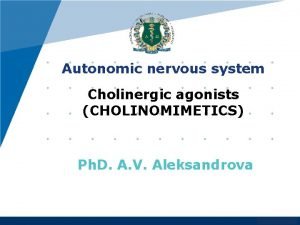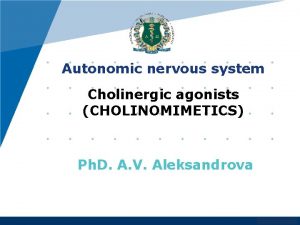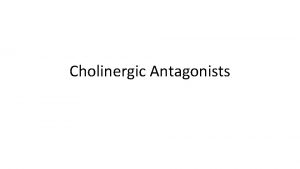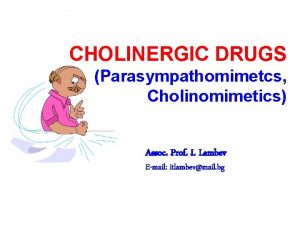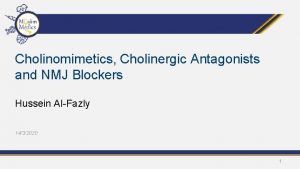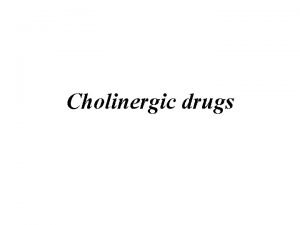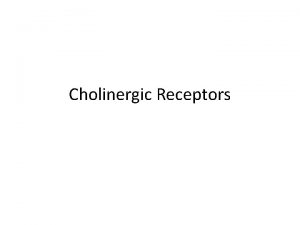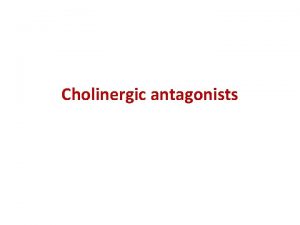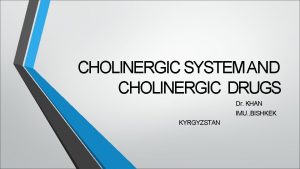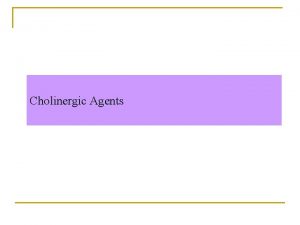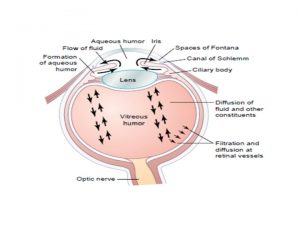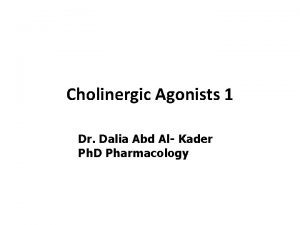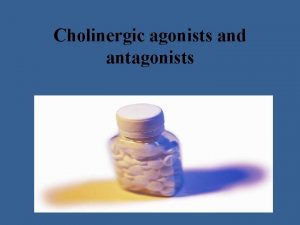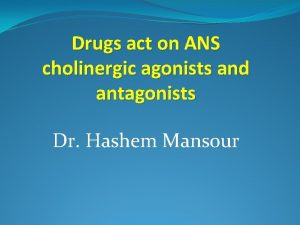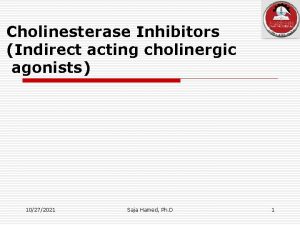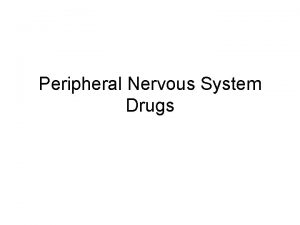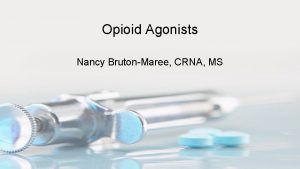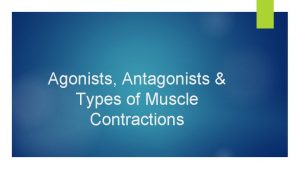Cholinergic Agonists DirectActing Cholinomimetics DirectActing Cholinergic Agonists N

































- Slides: 33


Cholinergic Agonists







Direct-Acting Cholinomimetics üDirect-Acting Cholinergic Agonists (N & M) üCholinergic agonists (parasympathomimetics) mimic the effects of ACh on cholinoceptors. üThese agents broadly classified into: v. Endogenous choline esters, Ach v. Synthetic esters of choline, carbachol and bethanechol. v. Naturally occurring alkaloids, nicotine, pilocarpine ü All of the direct-acting cholinergic drugs have longer durations of action than acetylcholine üAs a group, the direct-acting agonists show little specificity in their actions, which limits their clinical usefulness

Acetylcholine (Ach) üQuaternary ammonium compound -------üSite of action -------üBoth muscarinic and nicotinic activity üTherapeutic uses ----ü HR & CO (vagal stimulation). üEffect of IV Ach on: I. Heart: ------ due to ---------

II. Blood Pressure Injection of Ach vasodilation and lowering BP ( indirect mechanism of action) activates M 3 receptors on endothelial cells lining SM of BVs production of nitric oxide from arginine NO diffuses to vascular SM stimulates PK G production hyperpolarization (SM relaxation through PDE-3 inhibition)

III. Other Actions of ACh • GIT: increases salivary secretion and stimulates intestinal secretions and motility. • Bronchiolar secretions are also enhanced. • Genitourinary tract: the tone of the detrusor urinae muscle is increased, causing expulsion of urine. • Eye, stimulating ciliary muscle contraction for near vision • Constriction of the pupillae sphincter muscle, causing miosis • Acetylcholine (1% solution) is instilled into the anterior chamber of the eye to produce miosis during ophthalmic surgery.

The Eye

Adverse Effects of Cholinomimetics

Bethanechol • Structurally related to Ach (in which the acetate is replaced by carbamate and the choline is methylated). • Not hydrolyzed by ACh. E (addition of carbonic acid), / inactivated by other esterases. • lacks N actions / have strong M activity • Major actions / SMs of the bladder & GIT. • Duration of action of about 1 hour.

Bethanechol (cont. ) • Actions: • Direct effect on MRs, intestinal motility & tone? ? ? • Detrusor Ms of the bladder ? ? ? whereas the trigone & sphincter ? ? ? • Therapeutic applications: • Stimulate the atonic bladder, particularly in postpartum or postoperative, nonobstructive urinary retention. • Neurogenic atony ( poor muscular condition ) • Megacolon (Hypertrophy & dilation of colon with prolonged constipation). • Adverse effects: generalized cholinergic stimulation (? ? ? )

Carbachol (carbamylcholine) üPotent M & N agonist üEster of carbamic acid / poor substrate of ACh. E ü Actions: üOn both the CVS & GIT (? ? ? ) üRelease of Epi / adrenal medulla üMiosis and a spasm of accommodation ? ? ? ü Therapeutic uses: üRarely used therapeutically ? ? ? except as a miotic / glaucoma üAdverse effects: at ophthalmic doses ? ? ?

Glaucoma • A disease that damages optic nerve. • Occurs when extra fluid increases the pressure on the front chamber of the eye. • A leading cause of blindness for people over 60 years old • Blindness can often be prevented with early treatment.

Types of glaucoma ØPrimary open-angle glaucoma • Most common, occurs gradually, where the eye does not drain fluid • Eye pressure builds and starts to damage the optic nerve. • Painless and causes no vision changes at first. ØAngle-closure glaucoma (also called “closed-angle glaucoma” or “narrowangle glaucoma”, acute) • The iris is very close to the drainage angle in the eye. • The iris can end up blocking the drainage angle, eye pressure rises very quickly.

Pilocarpine • Alkaloid / 3◦ amine /stable to hydrolysis by ACh. E • Less potent than Ach / high penetration to CNS • M agonist used in ophthalmology. • Miosis and contraction of the ciliary muscle, spasm of accommodation • Stimulator of sweat, tears, and saliva • Beneficial in promoting salivation in patients with xerostomia resulting from irradiation of the head and neck • Sjögren syndrome (immune system attacks the glands that make tears and saliva (spit). The damage keeps these glands from working right and causes dry eyes and dry mouth)

Pilocarpine (cont. ) • Drug of choice for emergency lowering IOP of both open-angle and angle-closure glaucoma • Within a few minutes, lasts 4 to 8 hours, and can be repeated • Topical carbonic anhydrase inhibitors, such as dorzolamide and β-adrenergic blockers such as timolol, are effective in treating glaucoma but are not used for emergency lowering of intraocular pressure • The miotic action of pilocarpine is also useful in reversing mydriasis due to atropine

Pilocarpine (cont. ) Adverse effects: • blurred vision, night blindness • Poisoning with this agent is characterized by exaggeration of various parasympathetic effects, including profuse sweating (diaphoresis) and salivation. • Parenteral atropine, at doses that can cross the blood–brain barrier, is administered to counteract the toxicity of pilocarpine.


Indirect Cholinergic Agonists Anticholinesterases (Reversible)

Edrophonium • Short acting 4◦ amine (10 -20 min) due to renal excretion • Used in the diagnosis of myasthenia gravis. • IV injection of edrophonium leads to a rapid increase in muscle strength • Care must be taken / cholinergic crisis. (atropine is the antidote) • Used to reverse nondepolarizing NMJ

Physostigmine • Natural 3◦ amine, 30 min – 2 hrs (intermediate) • intestinal and bladder motility / atony of either organ • Topically on the eye, miosis and spasm of accommodation, as well as IOP used to treat glaucoma / pilocarpine is more effective. • Used for overdoses of drugs with anticholinergic actions, such as atropine, phenothiazines, and tricyclic antidepressants. • Adverse effects: • CNS / convulsions when high doses are used • Bradycardia and a fall in CO may also occur. • Paralysis of skeletal muscle.

• Pyridostigmine and ambenomium: • cholinesterase inhibitors that are used in the chronic management of myasthenia gravis. • Adverse effects similar to those of neostigmine • Tacrine, donepezil, rivastigmine, and galantamine: • patients with Alzheimer's disease have a deficiency of cholinergic neurons in the CNS • led to the development of anticholinesterases as possible remedies for the loss of cognitive function • Tacrine was the first to become available, but it has been replaced by the others because of its hepatotoxicity. • Donepezil, Rivastigmine, & Galantamine / delay the progression disease, none can stop its progression • Gastrointestinal distress is their primary adverse effect

Irreversible Anti-Cholinesterase Agents (Indirect –Acting Cholinergic Agonists) v. Synthetic organophosphate cpds v. Bind covalently v. Used for military & agriculture • Echothiophate • Organophosphate covalently binds via its phosphate group at the active site of ACh. E / permanently inactivated • Restoration of ACh. E activity ? ? ? • Aging / impossible for chemical reactivators

• Actions: generalized cholinergic stimulation, paralysis of motor function (causing breathing difficulties), and convulsions • Miosis, decrease IOP • Atropine in high dosages can reverse many of the peripheral and some of the central muscarinic effects of echothiophate. • Therapeutic uses: • treatment of open-angle glaucoma/rarely used

• • Irreversible ACh. E inhibitors (mostly organophosphate compounds) are used as agricultural insecticides /led to numerous cases of accidental poisoning with these agents • frequently used for suicidal and homicidal purposes • Organophosphate nerve gases, e. g. Sarin used as agents of warfare and chemical terrorism • Toxicity with these agents is manifested as nicotinic and muscarinic signs and symptoms (cholinergic crisis

Reactivation of acetylcholinesterase Ø Pralidoxime (2 -PAM) can reactivate inhibited ACh. E Ø Unable to penetrate into the CNS and therefore is not useful in treating the CNS effects of organophosphates Ø If given before aging / reverse both M & N peripheral effects of organophosphates, but not the CNS effects Ø With the newer nerve agents that produce aging of the enzyme complex within seconds Ø Pralidoxime is a weak ACh. E inhibitor and, at higher doses, may cause side effects similar to other ACh. E inhibitors

• Other treatments • Atropine ? ? ? • Diazepam is also administered to reduce the persistent convulsion caused by these agents • General supportive measures, such as maintenance of patient airway, oxygen supply, and artificial respiration

 Direct acting cholinergic agonist drugs
Direct acting cholinergic agonist drugs Indirect acting cholinergic agonists
Indirect acting cholinergic agonists Anticholinesterase
Anticholinesterase Cholenergic
Cholenergic M cholinoblockers
M cholinoblockers Cl channel
Cl channel Sar of cholinergic drugs
Sar of cholinergic drugs Cholinergic crisis
Cholinergic crisis Cholinergic
Cholinergic Cholinergic drugs act on receptors normally stimulated by
Cholinergic drugs act on receptors normally stimulated by Cholinergic crisis
Cholinergic crisis Adrenergic vs cholinergic
Adrenergic vs cholinergic Adrenergic and cholinergic difference
Adrenergic and cholinergic difference Parasympathetic and cholinergic
Parasympathetic and cholinergic The scale of things
The scale of things Cholinergic interneurons striatum
Cholinergic interneurons striatum Cholinergic receptors
Cholinergic receptors Tropicamaide
Tropicamaide Cholinergic crisis
Cholinergic crisis Cholinergic drugs classification
Cholinergic drugs classification Cholinergic toxidrome
Cholinergic toxidrome Dumbbells cholinergic
Dumbbells cholinergic Cholinergic
Cholinergic Cholinergic toxidrome
Cholinergic toxidrome Cholinergic crisi
Cholinergic crisi Anticholinergic examples
Anticholinergic examples Anticholinergic vs antimuscarinic
Anticholinergic vs antimuscarinic Cholinergic agents
Cholinergic agents Adrenergic fibers sympathetic or parasympathetic
Adrenergic fibers sympathetic or parasympathetic Cholinergic
Cholinergic
